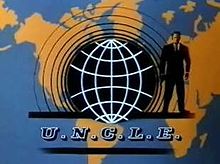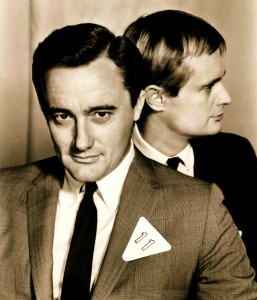The Man from U.N.C.L.E.
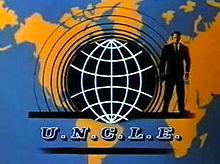
The From Uncle Season One Long Opening
This is the opening title sequence from the seventh episode of UNCLE’s first season, THE GIUOCO PIANO AFFAIR (November 10, 1964), featuring Jerry Goldsmith’s original theme. For the first few episodes, Napoleon Solo, Illya Kuryakin and Alexander Waverly introduced themselves to the viewing audience. Also included in the title sequence was a nameless voiceover explaining the basics of the U.N.C.L.E. organization and its front of Del Floria’s Tailor Shop.
The Man from U.N.C.L.E. is an American television series broadcast on NBC from September 22, 1964, to January 15, 1968. It follows secret agents, played by Robert Vaughn and David McCallum, who work for a secret international espionage and law-enforcement agency called U.N.C.L.E. Originally co-creator Sam Rolfe wanted to leave the meaning of U.N.C.L.E. ambiguous so it could refer to “Uncle Sam” or the United Nations. Concerns by the MGM legal department about using “U.N.” for commercial purposes resulted in the producers’ clarification that U.N.C.L.E. was an acronym for the United Network Command for Law and Enforcement. Each episode had an “acknowledgement” to the U.N.C.L.E. on the end titles.
Background
The series consisted of 105 episodes originally screened between 1964 and 1968. It was produced by Arena Productions using the studios of Metro-Goldwyn-Mayer. The first season was broadcast in black-and-white.
Ian Fleming contributed to the concepts after being approached by the show’s co-creator, Norman Felton. The book The James Bond Films says Fleming proposed two characters, Napoleon Solo and April Dancer (The Girl from U.N.C.L.E.). The original name was Ian Fleming’s Solo. Robert Towne, Sherman Yellen, and Harlan Ellison wrote scripts for the series. Author Michael Avallone, who wrote the first original novelisation based upon the series (see below), is sometimes incorrectly cited as the show’s creator.
Solo was to have been the focus, but a scene featuring a Georgian (Georgia-USSR) agent named Illya Kuryakin drew enthusiasm from the fans and the agents were paired.
Premise
The series centered on a two-man troubleshooting team working for U.N.C.L.E. (United Network Command for Law and Enforcement): American Napoleon Solo (Robert Vaughn), and Georgian (Georgia-USSR) Illya Kuryakin (David McCallum). Leo G. Carroll played Alexander Waverly, the British head of the organization (Number One of Section One). Barbara Moore joined the cast as Lisa Rogers in the fourth season.
The series, though fictional, achieved such cultural prominence that props, costumes and documents, and a video clip are in the Ronald Reagan Presidential Library’s exhibit on spies and counterspies. Similar U.N.C.L.E. exhibits are in the museums of the Central Intelligence Agency and other US agencies and organizations gathering intelligence.
U.N.C.L.E.’s adversary was T.H.R.U.S.H. (W.A.S.P. in the pilot movie). The original series never divulged what T.H.R.U.S.H. represented, but in several U.N.C.L.E. novels by David McDaniel, it is the Technological Hierarchy for the Removal of Undesirables and the Subjugation of Humanity, described as founded by Col. Sebastian Moran after the death of Professor Moriarty at the Reichenbach Falls in the Sherlock Holmes story, “The Final Problem”.
T.H.R.U.S.H.’s aim was to conquer the world. Napoleon Solo said, in “The Green Opal Affair”, “T.H.R.U.S.H. believes in the two-party system — the masters and the slaves,” and in the pilot episode (“The Vulcan Affair”), T.H.R.U.S.H. “kills people the way people kill flies — a reflex action — a flick of the wrist.” So dangerous was T.H.R.U.S.H. that governments — even those ideologically opposed, such as the United States and the Soviet Union — had cooperated in formatting and operating the U.N.C.L.E. organization. Similarly, when Solo and Kuryakin held opposing political views, the friction between them in the story was held to a minimum.
Though executive producer Norman Felton and Ian Fleming conceived Napoleon Solo, it was producer Sam Rolfe who created the U.N.C.L.E. hierarchy. Unlike national organizations like the CIA and James Bond’s MI6, U.N.C.L.E. was a global organization of agents from many countries and cultures. Illya Kuryakin was created by Rolfe as just such an agent, from the Soviet Union.
The creators decided an innocent character would be featured in each episode, giving the audience someone with whom to identify. Despite many changes over four seasons, “innocence” remained a constant — from a suburban housewife in the pilot, “The Vulcan Affair” (film version: To Trap a Spy) to those kidnapped in the final episode, “The Seven Wonders of the World Affair.”
The Pilot
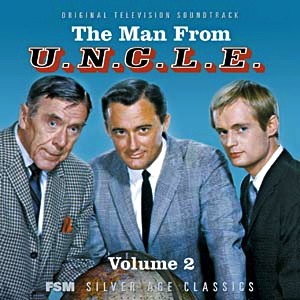 This section needs additional citations for verification. Please help improve this article by adding citations to reliable sources. Unsourced material may be challenged and removed. (November 2014) Filmed in color from late November to early December 1963 with locations at a Lever Brothers soap factory in California, the show was originally Ian Fleming’s Solo and later just Solo. However, in February 1964 a law firm representing James Bond movie producers Harry Saltzman and Albert R. Broccoli demanded an end to the use of Fleming’s name in connection with the series and an end to use of the name and character “Solo,” “Napoleon Solo” and “Mr. Solo”. At that time filming was under way for the Bond movie Goldfinger, in which Martin Benson was playing a supporting character named “Mr. Solo”. The claim was the name “Solo” had been sold to them by Fleming, and Fleming could not again use it. Within five days Fleming had signed an affidavit that nothing in the Solo pilot infringed any of his Bond characters, but the threat of legal action resulted in a settlement in which the name Napoleon Solo could be kept but the title of the show had to change.
This section needs additional citations for verification. Please help improve this article by adding citations to reliable sources. Unsourced material may be challenged and removed. (November 2014) Filmed in color from late November to early December 1963 with locations at a Lever Brothers soap factory in California, the show was originally Ian Fleming’s Solo and later just Solo. However, in February 1964 a law firm representing James Bond movie producers Harry Saltzman and Albert R. Broccoli demanded an end to the use of Fleming’s name in connection with the series and an end to use of the name and character “Solo,” “Napoleon Solo” and “Mr. Solo”. At that time filming was under way for the Bond movie Goldfinger, in which Martin Benson was playing a supporting character named “Mr. Solo”. The claim was the name “Solo” had been sold to them by Fleming, and Fleming could not again use it. Within five days Fleming had signed an affidavit that nothing in the Solo pilot infringed any of his Bond characters, but the threat of legal action resulted in a settlement in which the name Napoleon Solo could be kept but the title of the show had to change.
The role of the head of U.N.C.L.E. in the pilot was Mr. Allison, played by Will Kuluva, rather than Mr. Waverly played by Leo G. Carroll, and David McCallum’s Illya Kuryakin only had a brief role. Revisions to some scenes were shot for television, including those needed to feature Leo G. Carroll. The pilot episode was re-edited to fit an hour, converted to black and white, and shown on television as “The Vulcan Affair.”
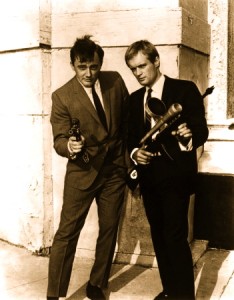 NBC in New York was not happy with the pilot. An executive wanted to drop someone but could not remember his name, saying “K…K…” and Felton replied “Kuluva?” and the executive replied “‘That’s it.'” Felton did not argue as he wanted to replace Kuluva anyway. Felton told the executives he wanted to replace Kuluva with Leo G. Carroll. The executive asked who was the guy replaced by Leo G. Carroll? Felton responded “Will Kuluva” and the executive said he meant David McCallum — Kuryakin. He wanted to get rid of the Russian and thought Carroll too old to be Solo’s sidekick. Felton said the contracts had been signed.
NBC in New York was not happy with the pilot. An executive wanted to drop someone but could not remember his name, saying “K…K…” and Felton replied “Kuluva?” and the executive replied “‘That’s it.'” Felton did not argue as he wanted to replace Kuluva anyway. Felton told the executives he wanted to replace Kuluva with Leo G. Carroll. The executive asked who was the guy replaced by Leo G. Carroll? Felton responded “Will Kuluva” and the executive said he meant David McCallum — Kuryakin. He wanted to get rid of the Russian and thought Carroll too old to be Solo’s sidekick. Felton said the contracts had been signed.
Additional color sequences with Luciana Paluzzi were shot in April 1964 and added to the pilot for MGM to release it outside the United States as a second feature titled To Trap a Spy. It premiered in Hong Kong in November 1964. The extra scenes were reedited to tone down sexuality and used in the regular series, in the episode “The Four-Steps Affair”.
Beyond extra scenes for the feature film, and revised scenes shot and edits made for the television episode, there are other differences among the three versions of the story. Before the show went into full production there was concern from MGM that the name of T.H.R.U.S.H. for the pilot’s international criminal organization sounded too much like SMERSH, the international spy- killing organization in Fleming’s Bond series. The studio suggested Raven, Shark, Squid, Vulture, Tarantula, Snipe, Sphinx, Dooom, and Maggot (the last used in early scripts). Although no legal action took place, the name was dubbed as “WASP” in the feature version To Trap a Spy. The original pilot kept T.H.R.U.S.H. (presumably as it was not intended to be released to the public in that version). Felton and Rolfe pushed for the reinstatement of T.H.R.U.S.H. It turned out that WASP could not be used as British television series Stingray was based on an organization called WASP — the World Aquanaut Security Patrol. By May 1964, T.H.R.U.S.H. was retained for the television episode edit of the pilot. Despite this, WASP was used in the feature film in Japan in late 1964 and left in the U.S. release in 1966. Another change among the three versions of the pilot story was the cover name for the character of Elaine May Donaldson. In the original pilot it was Elaine Van Nessen; in the television version as well as the feature version it was Elaine Van Every. Illya Kuryakin’s badge number is 17 in the pilot rather than 2 during the series. And Solo’s hair, which after new footage was added changed back and forth from a slicked back style to the less severe style he wore throughout the series.
With the popularity of the show and the spy craze, To Trap a Spy and the second U.N.C.L.E. feature The Spy with My Face were released in the USA as an MGM double feature in early 1966.
Season 1
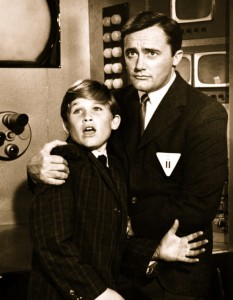 Vaughn and a young Kurt Russell in “The Finny Foot Affair.”
Vaughn and a young Kurt Russell in “The Finny Foot Affair.”
The show’s first season was in black and white. Rolfe created a kind of Alice’s Adventures In Wonderland world, where mundane everyday life would intermittently intersect with the looking-glass fantasy of international espionage which lay just beyond. The U.N.C.L.E. universe was one where the weekly “innocent” would get caught up in a series of fantastic adventures, in a battle of good and evil. Rolfe also blended deadly suspense with a light touch, reminiscent of Hitchcock. In fact, U.N.C.L.E. owes just as much to Alfred Hitchcock as it does to Ian Fleming, the touchstone being North by Northwest, where an innocent man is mistaken for an agent of a top-secret organization, one of whose top members is played by Leo G. Carroll. This role led directly to Carroll being cast as Mr. Waverly in the show.
U.N.C.L.E. headquarters in New York City was most frequently entered by a secret entrance in Del Floria’s Tailor Shop. Another entrance was through The Masque Club. Mr. Waverly had his own secret entrance. Unlike the competing TV series I Spy however, the shows were overwhelmingly shot on the MGM back lot. The same building with an imposing exterior staircase was used for episodes set throughout the Mediterranean area and Latin America, and the same dirt road lined with eucalyptus trees on the back lot in Culver City stood in for virtually every continent of the globe. The episodes followed a naming convention where each title was in the form of “The Affair,” such as “The Vulcan Affair,” “The Mad, Mad, Tea Party Affair”, and “The Waverly Ring Affair,” etc. The only exception was “Alexander the Greater Affair,” parts 1 & 2. The first season episode “The Green Opal Affair” establishes that U.N.C.L.E. itself uses the term “Affair” to refer to its different missions.
Rolfe endeavored to make the implausibility of it all seem not only feasible but entertaining. In the series, frogmen emerge from wells in Iowa, shootouts occur between U.N.C.L.E. and THRUSH agents in a crowded Manhattan movie theater, and top-secret organizations are hidden behind innocuous brownstone facades.
The series also began to dabble in science fictional plots, beginning with “The Double Affair” in which a THRUSH agent, made to look like Solo through plastic surgery, infiltrates a secret U.N.C.L.E. facility where an immensely powerful weapon called “Project Earthsave” is stored; according to the dialogue, the weapon was developed to protect against a potential alien threat to Earth. The Spy with My Face was the theatrical film version of this episode.
In its first season The Man from U.N.C.L.E. competed against The Red Skelton Show on CBS and Walter Brennan’s short-lived The Tycoon on ABC. During this time producer Norman Felton told Alan Caillou and several of the series writers to make the show more tongue in cheek.
Seasons 2–4
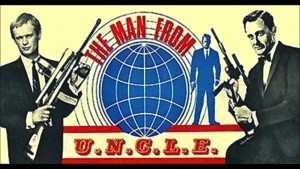 Switching to color, U.N.C.L.E. continued to enjoy huge popularity. Succeeding Rolfe, who left the show at the conclusion of the first season, new showrunner David Victor read articles that called the show a spoof and that is what it became. Over the next three seasons, five different show runners would supervise the U.N.C.L.E. franchise, and each one took the show in a direction that differed considerably from that of the first season. Furthermore, U.N.C.L.E. had spawned a swarm of imitators. In 1964, it was the only American spy show on U.S. TV; by 1966, there were nearly a dozen. In an attempt to emulate the success of ABC’s mid-season hit, Batman, which had proven hugely popular on its debut in early 1966, U.N.C.L.E. moved swiftly towards self-parody and slapstick.
Switching to color, U.N.C.L.E. continued to enjoy huge popularity. Succeeding Rolfe, who left the show at the conclusion of the first season, new showrunner David Victor read articles that called the show a spoof and that is what it became. Over the next three seasons, five different show runners would supervise the U.N.C.L.E. franchise, and each one took the show in a direction that differed considerably from that of the first season. Furthermore, U.N.C.L.E. had spawned a swarm of imitators. In 1964, it was the only American spy show on U.S. TV; by 1966, there were nearly a dozen. In an attempt to emulate the success of ABC’s mid-season hit, Batman, which had proven hugely popular on its debut in early 1966, U.N.C.L.E. moved swiftly towards self-parody and slapstick.
This campiness was most in evidence during the third season, when the producers made a conscious decision to increase the level of humor, though season two had moved in this direction in episodes such as “The Yukon Affair” and “The Indian Affairs Affair.” With episodes like “The My Friend the Gorilla Affair” (which featured a scene in which Solo is shown dancing with a gorilla) the show tested the loyalties of its fans. This new direction resulted in a severe ratings drop, and nearly resulted in the show’s cancellation. It was renewed for a fourth season and an attempt was made to go back to serious storytelling, but the ratings never recovered and U.N.C.L.E. was cancelled midway through the season.

